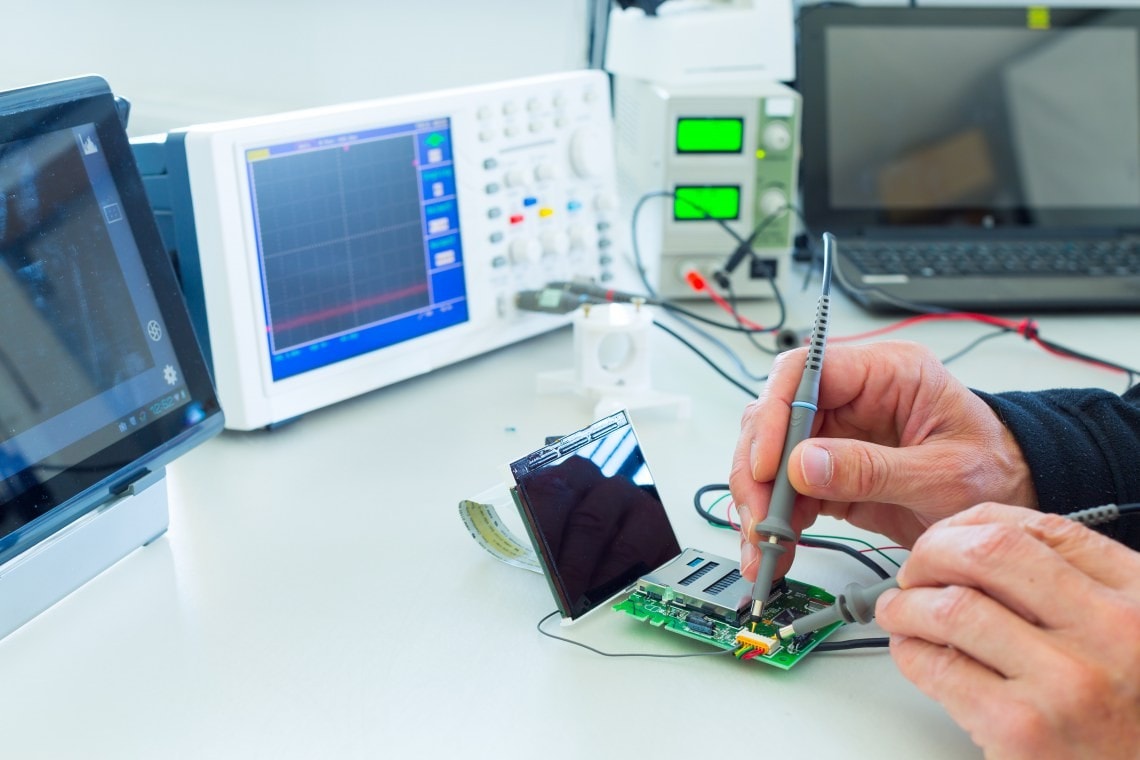Live Chat
Need Help?
Privacy PolicyHigh-Quality and Flight-Critical Transient Voltage Suppressors/ESD suppressors
Designed to protect sensitive components from electrical overstress due to events like lightning strikes, inductive load switching and electrostatic discharge, a Transient Voltage Suppressor (TVS)/ESD suppressors limits a voltage spike to a safe level. A TVS diode provides this critical protection by going into avalanche breakdown within no more than a few nanoseconds after a strike, clamping the transient voltage and routing its current to the ground. This solution can significantly improve equipment reliability and reduce losses due to transient voltage-related failures.
Our broad portfolio includes both unidirectional and bidirectional discreet plastic TVS devices with power levels ranging from 600W to 130 kW. These solutions are supported by qualification test plans and reliability monitoring that are in line with the best industry-standard practices.

MicroNotes: Transient Voltage Protection for Avionics and in Robust Environments
The need to provide multi-stroke and multi-burst lightening protection in a variety of applications is increasing, especially in new aircraft that are being built with mostly composite bodies. The RTCA DO-160 standard defines the test standards for these hazards in aeronautic products.
Our MicroNotes provide technical information about how our high-reliability plastic TVS devices are well suited to meet these requirements. Use the link below to download our MicroNotes Quick Reference Guide, or visit the Documentation area lower down on this page to read our selection of MicroNotes.

Latest News
MDA3KP TVS Diode Array Family
The MDA3KP Transient Voltage Suppressor (TVS) is a 3 kW diode array family consisting of more than 25 products with different screen levels, polarities and qualification standards. As the only available technology offering a comprehensive voltage range tested to a high reliability standard and qualified based on the MIL-PRF-19500 JANTX level equivalence standard, this family provides an integrated multi-diode solution. These voltage-clamping devices provide fast-reacting Avalanche Breakdown Diode (ABD) features that divert excess current around sensitive components to protect them from electrical overstress.
Low-Capacitance TVS Products
Features of our low-capacitance TVS diodes include:
- Reliable protection against transient voltage events in demanding environments
- An excellent fit for high-speed signal lines where minimal signal distortion is critical
- Robust construction
- Undergo rigorous testing and screening to meet stringent quality and reliability standards
- Protect sensitive electronic circuits in harsh operating conditions
- Long-term reliability and performance in aerospace, defense and other mission-critical applications where environmental factors such as humidity, temperature and pressure fluctuations can pose challenges
MSMAF Low-Profile TVS Diodes
Our low-profile, surface-mount 400W SMASF series Transient Voltage Suppressor (TVS) diodes are available in a flat-lead plastic package with standoff voltages from 5.8V to 214V and in unidirectional or bidirectional versions. Options include Sn/Pb or RoHS-compliant matte-tin plating. These high-reliability devices feature wafer fabrication and assembly lot traceability and undergo 100% surge testing with enhanced reliability screening similar to MIL-PRF-19500 standards. The moisture classification is Level 1, which eliminates the need for dry packing required by the IPC/JEDEC J-STD-020B standard. Additionally, 3σ lot-norm screening is performed on standby current (ID).
Plastic Large-Area Device (PLAD)
Our surface-mount PLAD TVS diodes play a crucial role in enabling avionics systems to comply with the latest safety standards mandated for modern carbon composite-skinned aircraft. By enhancing surge protection, our PLAD packaging effectively mitigates the risks of digital signal processing disruption, component damage and functional interruptions that are the indirect effects of lightning.
Our PLAD TVS diodes represent a breakthrough in surface-mount TVS packaging for 15 kW, 18 kW, 30 kW and 36 kW devices.
Powermite Products
Our Powermite product line includes surface-mount TVS and Schottky diodes for applications that demand robust transient voltage protection and efficient rectification. The Powermite TVS devices safeguard electronic circuits against voltage spikes in space-constrained environments, such as telecommunications, industrial equipment and automotive systems. The Powermite Schottky diodes deliver:
- Low forward-voltage drop
- Fast switching
- Highly efficient for rectification tasks in power supplies, voltage clamping and reverse-polarity protection circuits
Surface-Mount TVS Array
Our portfolio of surface-mount TVS array products includes 20 device families that meet the evolving needs of modern electronics and cater to a variety of applications requiring robust transient voltage protection. These TVS arrays are available in various surface-mount packages, including:
- QFN
- SOT-23
- SOT-143
- SO-8
- SO-14
- SO-16
They are compatible with different circuit designs and assembly processes. These TVS devices are available in both unidirectional and bidirectional configurations to provide protection against a wide variety of transient events.
Surface-Mount TVS Diodes
Our portfolio of surface-mount TVS diodes, which is tailored for diverse application needs, including the:
- SMA 500W
- SMB 600W
- SMC 1,500W
- SML 3,000W plastic surface-mount diodes in an SMC package
These compact devices with high surge capabilities offer robust protection against voltage transients and surges for electronic systems in telecommunications, automotive and industrial environments. We also provide high-reliability screening options for these TVS devices, which enables consistent performance and longevity in demanding applications.
15KP, 30KP, RT100KP Axial Devices
Our robust 15KP, 30KP and RT100KP axial TVS diodes provide reliable overvoltage protection in a variety of applications. Features of these axial devices include:
- High surge capability
- Low clamping voltage for effective suppression of voltage transients and surges
- Safeguard sensitive electronic components in industries such as telecommunications, automotive and industrial electronics

TVS Device Specifications
Offer a broad voltage and power spectrum for unidirectional and bidirectional Transient Voltage Suppressor (TVS) devices

Application Support Excellence
Provide industry-leading application support, including solutions tailored for DO-160 standards and unique requirements

Advanced Packaging Innovations
Utilize cutting-edge packaging technology for enhanced performance and reliability

Signal Protection Advancements
Implement signal protection with low-capacitance features

Quality Control in Manufacturing
Utilize controlled die foundries, along with designated assembly and screening facilities

Electrical Testing Standards
Employ comprehensive electrical testing capabilities

Reliability Assurance
Maintain ongoing reliability monitoring to ensure continuous performance standards
- Hermetic Families
- Non-Hermetic Families
- MDA3KP Diode Arrays
- MSMASF Diodes
- PLAD Diodes
- Surface-Mount Diodes
- Axial Device Diodes
- Low-Capacitance Diodes
- Surface Mount Diode Arrays
Similar Devices
Similar Devices
Similar Devices
Similar Devices
Similar Devices
Similar Devices
Similar Devices
Similar Devices
Similar Devices
TVS Applications
Product Brochures
Application Notes
|
Title
|
|
|---|---|
| Introduction to Rectifiers | Download |
| MicroNote 050: Radiation Hardened Performance of Discrete Semiconductor Products | Download |
| Rectifier Reverse Switching Performance | Download |
| MicroNote 30: Metallurgical Bond Evaluation Methods for Diodes | Download |
| Rectifier Bridges and Dual Rectifiers | Download |
| MicroNote 020: Plating and Solder Dipping | Download |
| MicroNote 135: Failure Mechanisms for TVS | Download |
| MicroNote 127: Lightning Protection for Aircraft Electrical Power and Data Communications Systems | Download |
| MicroNote 117: Protecting USB Data I/O Ports | Download |
| MicroNote 116: Transformer Protection | Download |
| MicroNote 131: Tutorial on Transient Voltage Suppression (TVS) Selection | Download |
| MIcroNote 115: Derating TVS for Varying Pulse Widths | Download |
| MicroNote 109: Protection from Electrostatic Discharge | Download |
| MicroNote 129: Upscreening Commercial TVS Diodes for Aviation and Robust Environments or Applications | Download |
| MicroNote 133: Repetitive Surge on TVS | Download |
| MicroNote 125: Selecting a TVS | Download |
| MicroNote 134: Zeners and TVS: Can Either be Used for the Same Application? | Download |
| MicroNote 113: Parallel Stacking TVS for Higher Surge Current | Download |
| MicroNote 122: TVS Protection Across High Data Rate and RF Lines | Download |
| MicroNote 107: Cross Referencing TVS Devices | Download |
| MIcroNote 118: TVS/Chip Product Overview | Download |
| MicroNote 114: Derating TVS at Elevated Temperatures | Download |
| MicroNote 112: Series Stacking TVS for Higher Surge Current | Download |
| MicroNote 111: Parasitic Lead Inductance in TVS | Download |
| MicroNote 123: Effective Use of Space Saving TVS Arrays | Download |
| MicroNote 121: Protecting Data I/O Parts with TVS Arrays | Download |
| MicroNote 130: Overall Selection of TVS Part Numbers | Download |
| MicroNote 110: Parasitic Capacitance in TVS | Download |
| MicroNote 108: Determining Clamping Voltage Levels for a Range of Pulse Currents | Download |
| MicroNote 104: Using the Power vs Time Curve | Download |
| MicroNote 105: What is a Thyristor Surge Protector Device | Download |
| MicroNote 106: Crowbars and Clamps | Download |
| MicroNote 101: A Primer on TVS Devices | Download |
| MicroNote 102: An Introduction to TVS Devices | Download |
| MicroNote 103: What is a TVS? | Download |
| MicroNote 120: Selecting TVS with PPP and Waveform Considerations | Download |
| MicroNote201 An Introduction To Zener Diodes | Download |
| MicroNote202 Zener voltage Regulation with current changes | Download |
| MicroNote006 Soldering Guidelines for Glass MELF Diodes | Download |
| MicroNote129 Upscreening commercial TVS diodes for avionics and robust environments or applications | Download |
| MicroNote108 Determining Clamping Voltage Levels for a Range of Pulse Currents | Download |
| MicroNote107 Cross Referencing TVS Devices | Download |
| MicroNote104 Using the Power vs Time Curve | Download |
| MicroNote060 Mil-PRF-19500 qual chips vs Mil PRF 38534 qual chips | Download |
| MicroNote035 Metallographic cross sectioning techniques for performance of destruct physical analysis of glass encapsulated diodes | Download |
| MicroNote070 Thermal Management for Discrete Semiconductors | Download |
| MicroNote401 Introduction to Schottky Rectifiers | Download |
| MicroNote303 Rectifier Bridges and Dual Rectifiers | Download |
| MicroNote205 Zero Temperature coefficient Reference Diodes | Download |
| MicroNote402 High Temperature Reverse Bias (HTRB) | Download |
| MicroNote203 Zener Voltage Regulation with Temperature | Download |
| MicroNote 501 Intro to Rectifier Bridges | Download |
| MicroNote601 Nanosecond SCR switch for reliable high current Pulse generators and Modulators | Download |
| MicroNote602 UPGA301A Pulse Circuit Analysis | Download |
| MicroNote603 Anode Gate Thyristors and High Current AC Applications | Download |
| MicroNote701 PIN Diode Fundamentals | Download |
| MicroNote1002 Calculating Reliability using FIT & MTTF: Arrhenius HTOL Model | Download |
| MicroNote304 Introduction To Photovoltaic By-Pass diodes | Download |
| MicroNote070_Final.pdf | Download |
| MicroNote 128: Unidirectional/Bidirectional TVS Differences | Download |
| MicroNote 204 Zener Voltage Regulation and Thermal Resistance | Download |
| MicroNote 010: How to Quickly Obtain Spice Data | Download |
| Aircraft Lightning Protection for ARINC & AFDX Protocols | Download |
| MicroNote 005: Care, Handling, and Solder Profile of Diodes | Download |
| MicroNote 132 Aircraft Lightning Protection | Download |


